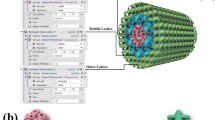Abstract
Although the R-curve has provided a convenient description of the crack growth resistance behavior for ceramic materials, its shape depends not only on intrinsic material properties, but also on the selected specimen geometry. Therefore, it is of general interest to isolate the geometry-independent material-specific effects. In the case of alumina, bridging stresses in the wake of a crack are responsible for the observed R-curve. In the present study, a procedure is demonstrated which enables one to determine the bridging stress relation from the initial part of the R-curve and post-fracture tensile (PFT) tests. Based on the bridging stresses, the complete R-curve, including large crack extensions, can be computed. The calculated R-curve agrees very well with experimental results.
Similar content being viewed by others
References
Ballarini, R., Shah, S.P. and Keer, L.M. (1984). Crack growth in cement-based composites, Engineering Fracture Mechanics 20, 433–445.
Broek, D. (1990). Elementary Engineering Fracture Mechanics, Martinus Nijhoff Publishers, Dordrecht.
Cox, B.N. and Marshall, D.B. (1991a). Stable and unstable solutions for bridged cracks in various specimens, Acta Metall. 39, 579–589.
Cox, B.N. and Marshall, D.B. (1991b). The determination of crack bridging forces, International Journal of Fracture 49, 159–176.
Fett, T. (1994). Contributions to the R-curve Behavior of Ceramic Materials, Report KfK 5291, Kernforschungszentrum Karlsruhe.
Fett, T. and Munz, D. (1997). Stress Intensity Factors and Weight Functions, Computational Mechanics Publications, Southampton.
Fett, T., Munz, D., Yu, C.T. and Kobayashi, A.S. (1994). Determination of bridging stresses in reinforced Al2O3, Journal of American Ceram. Society 77, 3267–3269.
Fett, T., Munz, D., Seidel, J., Stech, M., Rödel, J. (1996). Correlation between long and short crack R-curves in alumina using the crack opening displacement and fracture mechanical weight function approach, Journal of American Ceram. Society 79, 1189–1196.
Foote, R., Mai, Y.-W. and Cotterell, B. (1986). Crack growth resistance curves in strain-softening materials, Journal of Mechanics and Physics Solids 34, 593–607.
Grimes, R.E., Kelkar, G.P., Guazzone, L. and White, K.W. (1990). Elevated temperature R-curve behavior of a polycrystalline alumina, Journal of American Ceram. Society 73, 1399–1404.
Hay, J.C. and White, K.W. (1993). Grain-bridging mechanisms in monolithic alumina and spinel, Journal of American Ceram. Society 76, 1849–1854.
Hay, J.C. and White, K.W. (1995). Grain boundary phases and wake zone characterization in monolithic alumina, Journal of American Ceram. Society 78, 1025–1032.
Hillerborg, A., Modeer, M. and Petersson, P.-E. (1976). Analysis of crack formation and crack growth in concrete by means of fracture mechanics and finite elements Cem. Concr. Res 6, 773–781.
Hsueh, C.H. and Becher, P.F. (1988). Evaluation of bridging stress from R-curve behavior for nontransforming ceramics, Journal of American Ceram. Society 71, C-234–C-237.
Hu, X.-Z., Lutz, E.H. and Swain, M. (1991). Crack-rip-bridging stresses in ceramic materials, Journal of American Ceram. Society 74, 1828–1832.
Jenkins, M.G., Kobayashi, A.S., Sakai, M., White, K.W., Bradt, R.C. (1987). Fracture toughness testing of ceramics using a laser interferometric strain gage, Am. Ceram. Soc. Bull 66, 1734–1738.
Knehans, R. and Steinbrech, R. (1982). Memory effect of crack resistance during slow crack growth in notched Al2O3 bending specimens, Journal of Material Science Letters 1, 327–329.
Mai, Y.-W. and Lawn, B.R. (1987). Crack-interface grain bridging as a fracture resistance mechanism in ceramics: II. Theoretical fracture mechanics model, Journal of American Ceram. Society 70, 289–293.
Reichl, A. and Steinbrech, R. (1988). Determination of crack-bridging forces in alumina, Journa of American Ceram. Society 71, C-299–C-301.
Rice, J.R. (1972). Some remarks on elastic crack-tip stress fields, International Journal of Solids and Structures 8, 751–758.
Rödel, J., Kelly, J.G. and Lawn, B.R. (1990). In situ measurement of bridged crack interfaces in the scanning electron microscope, Journal of American Ceram. Society 73, 3313–3318.
Sharp, W.N. Jr. (1981). Interferometric surface strain measurement, J. Nondestructive Testing 3, 59–76.
Steinbrech, R.W., Reichl, A. and Schaarwächter, W. (1982). R-curve behavior of long cracks in alumina, Journal of American Ceram. Society 73, 2009–2015.
Steinbrech, R.W., Knehans, R. and Schaarwächter, W. (1983). Increase of crack resistance during slow crack growth in Al2O3 bend specimens, Journal of Materials Science 18, 265–270.
Steinbrech, R.W., Deuerler, F., Reichl, A. and Schaarwächter, W. (1988). Correlation of crack opening displacement and crack resistance curve of alumina, Science Ceram 14, 659–664.
Wecharatana, M. and Shah, S.P. (1983). A model for prediction fracture resistance of fiber reinforced concrete, Cem. Concr. Res 13, 819–829.
White, K.W. and Hay, J.C. (1994). The Effect of thermoelastic anisotropy on the R-curve behavior of monolithic alumina, Journal of American Ceram. Society 77, 2283–2288.
Author information
Authors and Affiliations
Rights and permissions
About this article
Cite this article
Fett, T., Munz, D., Dai, X. et al. Bridging stress relation from a combined evaluation of the R-curve and post-fracture tensile tests. International Journal of Fracture 104, 375–385 (2000). https://doi.org/10.1023/A:1007662309437
Issue Date:
DOI: https://doi.org/10.1023/A:1007662309437




